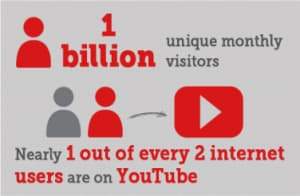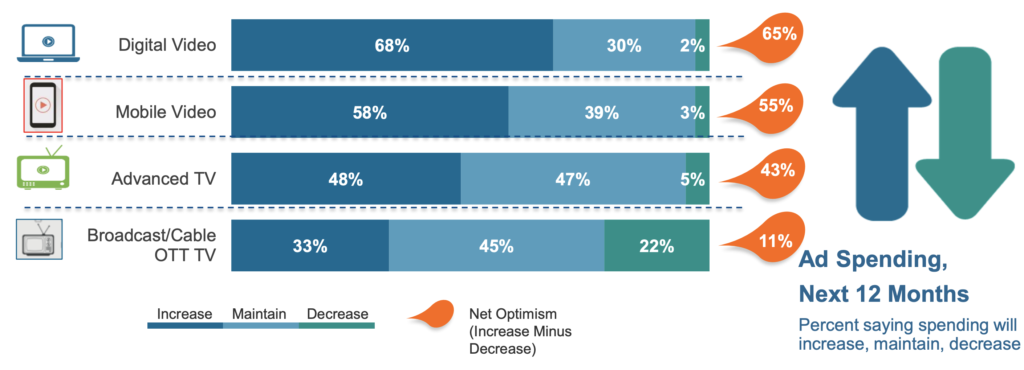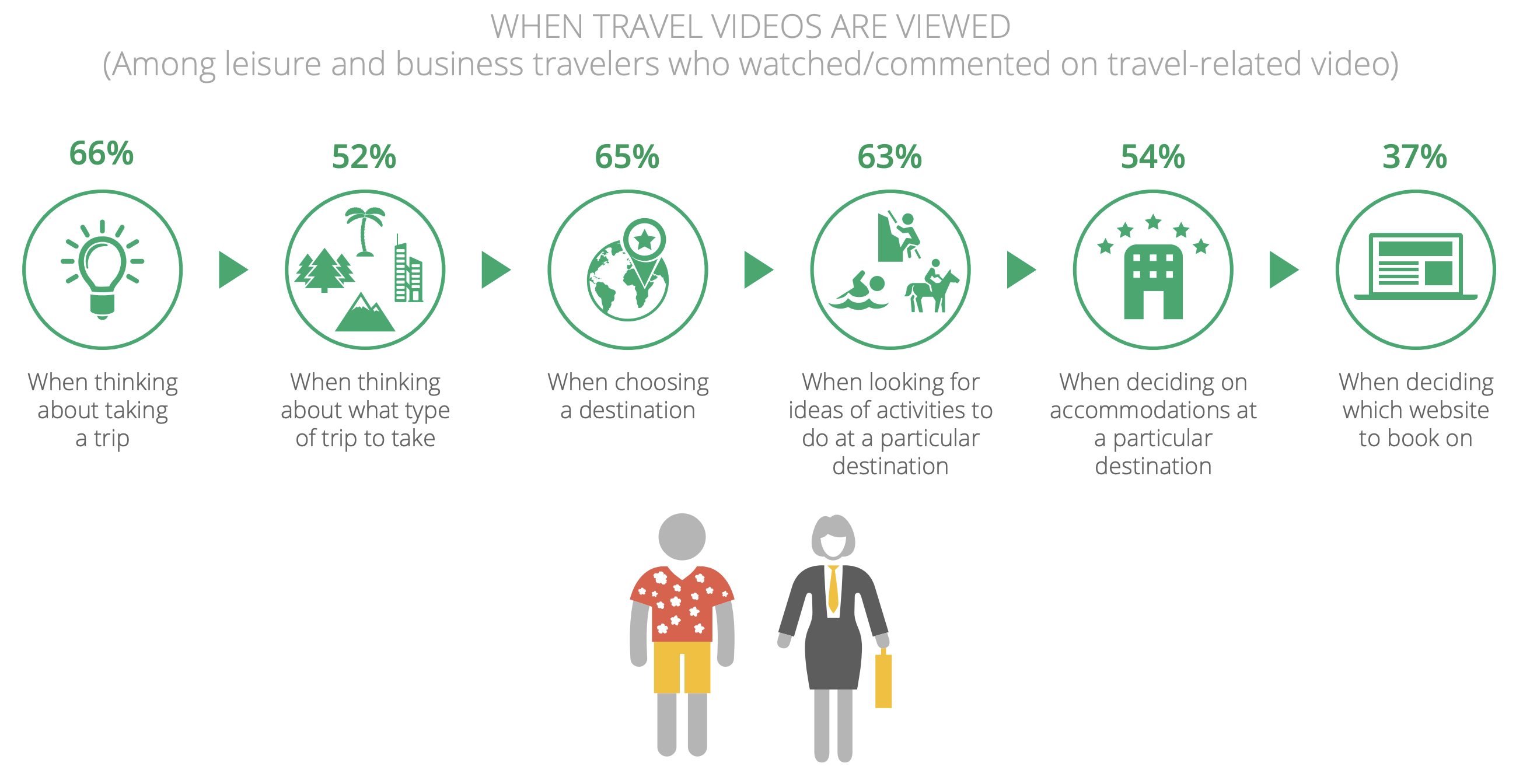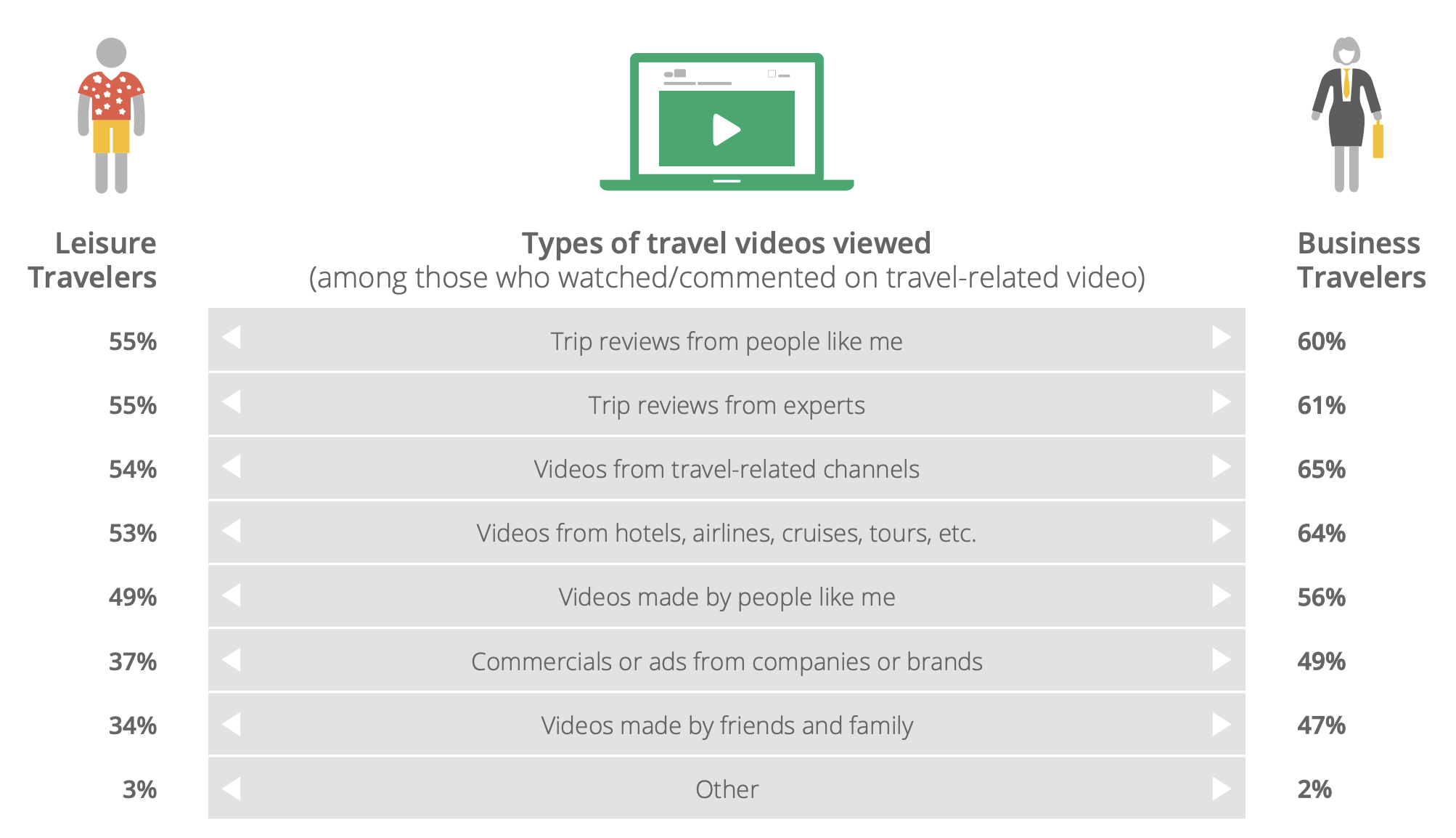Standing out in the online crowd has never been more important. The masses of content produced in an ever-shifting web environment make it hard for the consumer to find that ‘special something’ that makes your destination information unique. In this context, questions such as, ‘Which channels are the most important ones to reach your target groups?’, and, ‘How can you make sure your marketing efforts lead to the desired results?’, are inevitable.
While websites, social media, blogs and infographics dominated online travel information in the past, yet another channel has come into play and has proven itself successful: Online Video Content. While a recent study shows that 71% of travelers watch online video for travel inspiration, its potential to inform, educate, inspire and at the same time entertain a large audience is limitless. Many early adopters have already experienced outstanding results in terms of views and bookings, and some have even seen their videos go viral, giving their brands exposure, unlike any other medium.
Why is it important for destinations and travel marketers to make use of online video content? And how can the potential traveler be targeted? The following white paper is an attempt to provide answers to these questions and to give incentives to create engaging video content for today’s travelers.
1. Why Videos are Important for Today’s Travel Industry
Never before has video reached and engaged more people. Recent YouTube traffic data shows that one billion users visit their platform each month, which equals one in two people on the Internet at any given time.

Furthermore, YouTube’s online video portal has become the second most popular search engine after Google. There are many other online video platforms besides YouTube which enables the current trend of visual storytelling on the web.
ArrivalTV, a division of ArrivalGuides and the world’s largest provider of destination videos to Smart TV brands and set-top boxes (STBs), has experienced massive growth through alliances with new brand partners such as Foxxum, the front-runner in providing Smart TV solutions, and NetRange, a global supplier of Smart TV ecosystems.
Magnus Aideborn, CEO of ArrivalGuides, stated, “At ArrivalTV we firmly believe in the power of supplying destination videos which are inspiring and engaging, assisting travelers in their decision making processes. It has been shown that travelers engage heavily with online video with 66% of travelers watching travel videos when they are thinking about taking a trip and 65% watching when they are choosing a destination. This was reported by Google in their 2014 Travels Road to Decision Research Study.”
The Dominance of Online Video and Increasing Budgets for Video Marketing
While the importance and quantity of online video content have increased over the last years, recent insights show that video traffic is still on its rise. A Cisco white paper on traffic forecasts predicts that video will make up over 80% of global Internet traffic in 2019 (compared to 64% in 2014). Moreover, a million minutes of video content will cross the Internet every second.
Video in general, but mostly travel-related video content is showing substantial growth. In fact, YouTube data shows that travel videos, both professional and community generated, grew by 190% between 2012 and 2013. According to the Google Survey Travelers Road to Decision, 35% of leisure travelers and 56% of business travelers have watched travel-related videos within the past six months. Moreover, two out of three people are consuming travel-related video content when considering going on holidays. These numbers suggest that video plays a leading role in market awareness, and this has already been realized by marketers who are competing to reach audiences by telling stories to reinforce the brand.
The second annual Digital Content NewFronts: Digital Video Spend Study survey showed that over two-thirds (68%) of marketers expect to have a higher budget for digital video ads in the following year. The budgets were already increasing from spring 2013 until 2015 and the optimism seem to continue among brand advertisers and media buyers. It is expected that money will substantially shift from cable/broadcast TV to digital video.

While the growing presence of video on the future web should already be a striking argument to become a player in the online travel video market, there is also a qualitative momentum that should shake up a travel marketer’s content strategy.
2. The Power of Visual Storytelling – Videos and the Decision Making Process
The majority of travelers (65% of leisure time travelers and 69% of business travelers) start their travel research on the Internet. The fact that YouTube is among the top online sources for travel content, next to search engines such as Google, already highlights the leading role of videos for travel related content.

While videos are popular during the whole travel cycle, further results suggest that videos are consumed before decision making, in particular. According to Google, 66% view travel videos when they are thinking about taking a trip, 52% when thinking about what type of trip to take and 65% when choosing a destination (leisure and business travelers alike).

A major part of video consumption happens before the actual process of holiday planning, which means that video is a major source of inspiration and can influence a traveler’s decision-making process at a very early stage.
Only between 11% and 25% of travelers are certain which companies they will plan and book their holidays with regarding car rental, air travel, lodging, cruises, and vacation packages when they start research. The majority are open to different brands or undecided when they enter the activity of travel planning. As 77% use smartphones to inform themselves about traveling during life’s spare moments, for example when waiting, many decisions are made through online research on the go.
The video has the power to connect with the viewer on an emotional level that goes beyond mere travel information, which in turn may affect booking decisions and brand preferences. Moreover, a survey by CooperBridge Media has shown that 60% of users prefer a website with a video and visitors stay about 40% longer on those sites. 70% said they would rather book a hotel or attraction if they have seen a video in advance.
Content Expectation of Travel Videos – Authentic Information and the Rise of Branded Videos
The knowledge that video is popular among the mobile crowd and the insight that it is highly used at the beginning of a travel process naturally leads to yet another set of questions. What makes a video popular? What are viewers interested in and what do they prefer to watch?
The Travel Channel conducted studies aiming to find out how viewers connected to videos and found out that 71% of travelers watch videos as a source of travel inspiration. There was a strong desire that the actual video content is relatable to the viewer (“Would I do that?”) and that it should contain authentic and honest information (“Local view on culture”). The majority expects to learn something new in travel content (77%) or to learn more about things they want to do (77%). Moreover, 76% are looking for cultural information and connection and 72% want to get inspired. Results suggest that destinations have a great potential to reach a large audience with their videos if they give inspirational travel information rather than luxury and expensive travel suggestions and if they are open and honest in their presentations.
Besides these facts, a comparison of Google and YouTube data came to the result that 80% of searches for travel videos on YouTube concern information about destinations, attractions/points of interest or more general travel ideas. Again, this suggests a growing desire for inspirational content in videos. Regarding types of videos, Google’s Travelers Road to Decision survey found out that the majority of people who viewed travel videos (leisure and business travelers) want to see “trip reviews from people like me”, ”trip reviews from experts” “videos from travel-related channels” and “videos from hotels, airlines, cruises, tours etc.”

Furthermore, recent numbers show that branded videos are watched even more than community generated content. 62% of travelers that have consumed travel-related videos watched branded videos. Also, Google surveys underpin these results. While 40% of travel video views on YouTube regard tourist destinations and attractions, the majority of travel-related content watched (67%) comes from brand sources. Moreover, a YOY comparison of YouTube from 2012-2013 showed that branded videos grew up to 394%.

3. Best Practice Examples of Travel Videos
Videos give marketers the opportunity to create informative and entertaining content and to transport local culture with a sense of humor and witty comment. Sharing insider’s tips and discoveries that go beyond mere documentation of the destination is much appreciated by the viewers and may even affect them on an emotional and behavioral level.
Many companies have shown that video is not only a powerful tool to engage viewers but also to connect with them on a deeper level. The following best practice cases are a source of inspiration and exemplify the above-mentioned findings on the growing importance of online travel video.
Going Viral and the Sharing Behavior on Social Media
With their Kobe vs. Messi series, Turkish Airlines made their videos go viral and a recent advertisement for Emirates, directed by the Oscar Nominee Bryan Buckley and starring Hollywood Star Jennifer Aniston, reached the masses in no time. Airlines pay a lot of attention to online spots as the VXSafetyDance of Virgin America showed. Without even boarding an airplane, over 6 million people watched these safety instructions for its unusual presentation and outstanding performance. Again, these efforts and successes show the increasing popularity of online video for the travel sector.

While the clicks might be an important currency to calculate success, it is the power of the community which can help a brand generate even more awareness. On Facebook, for example, a video is 12 times more likely to be shared than a link or a simple text post.
In today’s overflow of online content, it is crucial to stand out and to make yourself known. Online video has become an important player and marketers have already embraced its potential to reach travelers at various stages in their travel planning process. Video can not only excite viewers during watching but may even connect them and others closer to the brand as they are being shared on social media such as Facebook.

Embracing the Future of Online Travel Video
ArrivalTV and its cooperation with well-known Smart TV brands such as Foxxum or NetRange, front-runners in Smart TV solutions and ecosystems, is a reaction to the fast developments in the online travel market.
Magnus Aideborn, CEO of ArrivalGuides, stated, “Through our partnerships we are available on over 90% of the world’s top selling Smart TVs. This relationship strengthens both, ArrivalGuides and partner brands, and we are committed to providing top quality destination videos to viewers all over the globe. Visual content enables destination brands to tell better stories. The real power lies in triggering people to action by providing them with high quality videos for destinations which inspire them to book.”
4. Make to most of your Online Travel Videos
By adding a video through ArrivalGuides CMS, partners are entering the network of the world’s largest provider of travel information and destination content. ArrivalTV, the online video division of ArrivalGuides, works with the most influential, major travel brands to publish comprehensive information about destinations. OTA’s, search engines, airlines, tour companies and travel operators comprise the over 340 distribution partner network, where destination information is provided as downloadable guides, available through apps, in-flight entertainment screens, booking confirmations, social media, and Smart TV apps.
ArrivalGuides currently has information representing over 600 destinations in their content library, supplied directly from tourist boards, major travel brands, and destination experts. ArrivalGuides destination partners, tourist boards, and DMOs, can upload unlimited videos to the ArrivalTV platform which are then available to millions of travelers. ArrivalGuides is constantly enlarging its network and guarantees exposure of videos through partners and distributors.
Aviva Pearson, President of ArrivalGuides, said, “ArrivalTV activates the desire to travel. Through our partnerships we are committed to providing top quality destination videos to viewers all over the globe.”
Get the most out of your online video content – join ArrivalGuides and upload your video to ArrivalTV today! ArrivalGuides can help to excel your brand and make your unique content stand out. For information on how to join the ArrivalGuides network and feel the power of being part of the world’s largest supplier of destination content, including videos, please email magnus.aideborn@arrivlaguides.com.
Author: Eva Thalhammer

